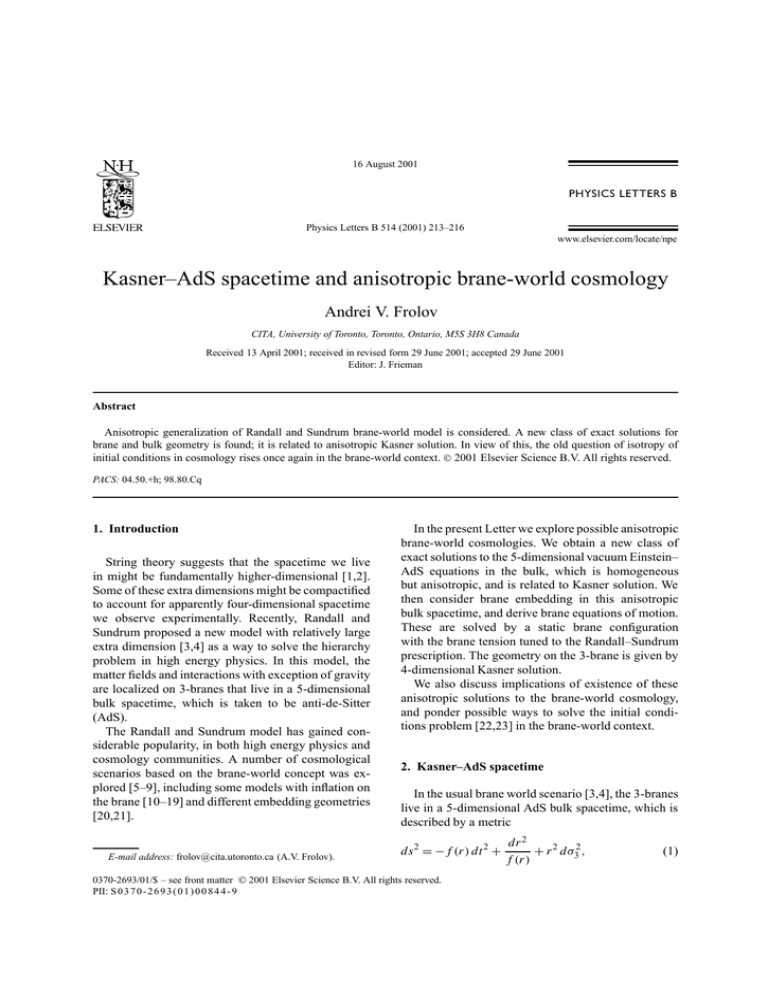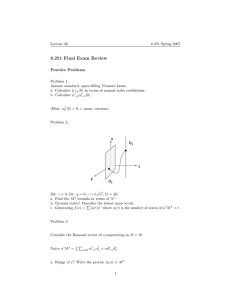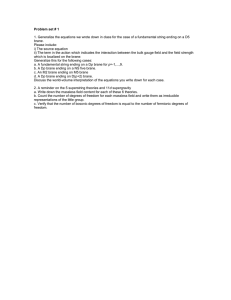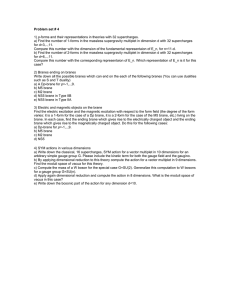
16 August 2001
Physics Letters B 514 (2001) 213–216
www.elsevier.com/locate/npe
Kasner–AdS spacetime and anisotropic brane-world cosmology
Andrei V. Frolov
CITA, University of Toronto, Toronto, Ontario, M5S 3H8 Canada
Received 13 April 2001; received in revised form 29 June 2001; accepted 29 June 2001
Editor: J. Frieman
Abstract
Anisotropic generalization of Randall and Sundrum brane-world model is considered. A new class of exact solutions for
brane and bulk geometry is found; it is related to anisotropic Kasner solution. In view of this, the old question of isotropy of
initial conditions in cosmology rises once again in the brane-world context. 2001 Elsevier Science B.V. All rights reserved.
PACS: 04.50.+h; 98.80.Cq
1. Introduction
String theory suggests that the spacetime we live
in might be fundamentally higher-dimensional [1,2].
Some of these extra dimensions might be compactified
to account for apparently four-dimensional spacetime
we observe experimentally. Recently, Randall and
Sundrum proposed a new model with relatively large
extra dimension [3,4] as a way to solve the hierarchy
problem in high energy physics. In this model, the
matter fields and interactions with exception of gravity
are localized on 3-branes that live in a 5-dimensional
bulk spacetime, which is taken to be anti-de-Sitter
(AdS).
The Randall and Sundrum model has gained considerable popularity, in both high energy physics and
cosmology communities. A number of cosmological
scenarios based on the brane-world concept was explored [5–9], including some models with inflation on
the brane [10–19] and different embedding geometries
[20,21].
E-mail address: frolov@cita.utoronto.ca (A.V. Frolov).
In the present Letter we explore possible anisotropic
brane-world cosmologies. We obtain a new class of
exact solutions to the 5-dimensional vacuum Einstein–
AdS equations in the bulk, which is homogeneous
but anisotropic, and is related to Kasner solution. We
then consider brane embedding in this anisotropic
bulk spacetime, and derive brane equations of motion.
These are solved by a static brane configuration
with the brane tension tuned to the Randall–Sundrum
prescription. The geometry on the 3-brane is given by
4-dimensional Kasner solution.
We also discuss implications of existence of these
anisotropic solutions to the brane-world cosmology,
and ponder possible ways to solve the initial conditions problem [22,23] in the brane-world context.
2. Kasner–AdS spacetime
In the usual brane world scenario [3,4], the 3-branes
live in a 5-dimensional AdS bulk spacetime, which is
described by a metric
ds 2 = −f (r) dt 2 +
0370-2693/01/$ – see front matter 2001 Elsevier Science B.V. All rights reserved.
PII: S 0 3 7 0 - 2 6 9 3 ( 0 1 ) 0 0 8 4 4 - 9
dr 2
+ r 2 dσ32 ,
f (r)
(1)
214
A.V. Frolov / Physics Letters B 514 (2001) 213–216
where dσ32 is a 3-dimensional metric of a unit sphere,
plane or hyperboloid for K = +1, 0, −1 respectively,
and
The spatial geometry in this case is homogeneous but
anisotropic, and is given by the metric
r2
f (r) = K + 2 ,
(2)
with giving the curvature scale of the AdS spacetime.
This bulk spacetime is a solution of vacuum Einstein–
AdS equations
(12)
1
Rµν − Rgµν = −Λgµν ,
2
with negative cosmological constant
(3)
6
(4)
.
2
We now generalize the spacetime (1) to include spatial anisotropy. For simplicity, we will only consider
spatially flat case (K = 0), for which the spatial part
of AdS metric was
Λ=−
dσ32 = dx 2 + dy 2 + dz2 .
(5)
In order to introduce anisotropy to the bulk spacetime,
yet keep the spatial slices homogeneous, we allow the
coefficients of the spatial metric to vary with time
dσ32 = e2a(t ) dx 2 + e2b(t ) dy 2 + e2c(t ) dz2 .
(6)
The vacuum Einstein–AdS equations (3) then give the
evolution of anisotropy scales a, b and c, which obey
three dynamical equations of motion, namely
ä + ȧ 2 − ḃċ = 0
(7)
and permutations thereof with respect to interchanges
of {a, b, c}, and a constraint
ȧ ḃ + ḃ ċ + ċȧ = 0,
b = β ln t,
Thus we have obtained a new solution (12), (11),
(1) of five-dimensional vacuum Einstein–AdS equations (3). It is related to the well-known Kasner
solution [24] of vacuum Einstein equations in four
dimensions (indeed, the three dimensional spatial line
elements are identical), so we will call it a Kasner–
AdS spacetime. Its properties with respect to spatial
anisotropy are similar to those of Kasner spacetime.
However, its global structure is different in that it not
only has a cosmological singularity at t = 0, but also
a timelike singularity at r = 0, where the curvature
diverges
Cαβγ δ C αβγ δ = −
164
αβγ .
r 4t 4
(13)
This does not pose a significant problem for the braneworld scenario, however, as the central part of the
spacetime is avoided in orbifold construction with two
branes, like the one considered in [3].
It is worth noting that similar generalization to 5dimensional AdS theory is possible for any Ricciflat 4-dimensional metric, Schwarzschild black hole
in particular [25]. It might be interesting to look
for spatially closed anisotropic solutions, as they are
likely to be of Mixmaster type and chaotic. However,
this topic is beyond the scope of this Letter. For several
other interesting generalizations of Kasner solution,
see [26–28].
(8)
where dot denotes derivatives with respect to time t.
The general solution of these equations, modulos the
translational and scaling freedom in the coordinate
choice, is
a = α ln t,
dσ32 = t 2α dx 2 + t 2β dy 2 + t 2γ dz2 .
c = γ ln t,
(9)
where parameters α, β and γ satisfy either
α = β = γ = 0,
(10)
in which case the original flat spatial metric (5) is
recovered, or
α 2 + β 2 + γ 2 = α + β + γ = 1.
(11)
3. Brane in anisotropic bulk
We now consider what will happen if the 3-brane is
embedded in the anisotropic Kasner–AdS spacetime
derived above, instead of the usual AdS spacetime.
Following [9], we describe the 3-brane embedding by
a hypersurface Σ defined by r = R(t). Induced braneworld metric is then
R,t2
2
dt 2 + R 2 dσ32
ds4 = − f −
f
= −dτ 2 + A2 dσ32 ,
(14)
A.V. Frolov / Physics Letters B 514 (2001) 213–216
where we introduced cosmological time
R,t2 1/2
dt,
dτ = f −
f
1/2
1
f + A2,τ
dτ
dt =
f
stress-energy tensor
2
Sab −
[Kab ] = −κD
(15)
and cosmological scale factor
A(τ ) = R(t (τ )).
(16)
The coordinates on the brane are {τ, x, y, z}, and the
corresponding holonomic basis vectors are
1/2
1
µ
f + Ȧ2
, Ȧ, 0, 0, 0
e(τ ) =
(17)
f
µ
µ
and e(i) = δi for index i spanning {x, y, z}. Here and
later the dot denotes the derivative with respect to
cosmological time τ . The outward pointing unit vector
normal to the brane is
Ȧ µ
2 1/2
, f + Ȧ
n =
(18)
, 0, 0, 0 .
f
By direct calculation, the extrinsic curvature tensor for
the brane embedded in the spacetime (1), (6), defined
as
µ
ν
nµ;ν ,
Kab = e(a)e(b)
(19)
has the following nonvanishing components:
1 Ä + f Kτ τ = − ,
2 f + Ȧ2
AȦ ∂a
+ f + Ȧ2 ,
Kxx = Ae2a
f ∂t
(20)
(21)
as well as Kyy and Kzz , which are the same as the
expression for Kxx above, except anisotropy scale a is
replaced by b and c correspondingly.
Assuming Z2 symmetry common to the braneworld models [1–9], the jump in extrinsic curvature
across the brane is
[Kab ] = ±2Kab ,
(22)
where sign depends on which side of the brane the bulk
is (plus if bulk is outside, i.e., towards the larger r, and
minus if bulk is inside, i.e., towards smaller r).
The jump in extrinsic curvature is caused by the
matter distribution on the brane; more precisely, Israel’s junction condition [29] links it with the surface
215
1
Sgab ,
D−2
(23)
where D is the dimensionality of the spacetime (D = 5
2 is D-dimensional Newton’s conin our case), and κD
stant. Together with expressions for extrinsic curvature (20), (21), junction condition (23) gives equations
of motion of the brane, provided the brane matter content is known.
Assuming the matter on the brane is composed of
vacuum energy of density λ and pressureless matter of
density ρ, the stress-energy tensor and its trace are
Sba = diag(−ρ − λ, −λ, −λ, −λ),
S = −ρ − 4λ.
(24)
The brane equations of motion are then
κ2
Ä + f = ± 5 (2ρ − λ),
3
f + Ȧ2
κ2
Ȧ ∂a
f
Ȧ2
+
+ 2 = ∓ 5 (ρ + λ),
2
f ∂t
6
A
A
(25)
(26)
plus two equations coming from yy and zz components of [Kab ], which are identical to the last equation, except anisotropy scale a is replaced by b and c
correspondingly. Since for anisotropic bulk a, b and
c depend on time differently (as given by Eq. (9)),
the only way to satisfy all equations simultaneously
without introducing anisotropic matter content on the
brane, is to have the anisotropic term in (26) vanish.
This is achieved when A = const, i.e., when brane is
not moving. In that case, the junction conditions (25),
(26) simplify greatly and become
κ2
κ2
1
= ± 5 (2ρ − λ) = ∓ 5 (ρ + λ).
6
6
(27)
They are satisfied (and thus anisotropic brane-world
construction is possible) when the brane parameters
are
λ=∓
6
,
κ52 ρ = 0,
(28)
which is precisely the tuning condition of Randall and
Sundrum [3,4].
216
A.V. Frolov / Physics Letters B 514 (2001) 213–216
4. Discussion
We have shown that the geometrical construction
of the Randall and Sundrum’s brane world [3] can
be carried out without assumption of spatial isotropy.
This results in a wider class of solutions of Einstein–
AdS equations in five dimensions that are anisotropic
in the bulk and have Kasner geometry on the brane.
Written in terms of fifth coordinate w = − ln(r/)
that Randall and Sundrum use, the spacetime metric is
ds 2 = e−2w/ −dt 2 + t 2α dx 2
+ t 2β dy 2 + t 2γ dz2 + dw2 .
(29)
In view of existence of such solutions, the old problem of initial conditions in cosmology [22,23] rises
once again, now in the brane-world context. The standard AdS brane-world solution is highly symmetrical
and essentially forms a set of measure zero among
the configuration space of possible solutions. Why
should we be living in such a special spacetime? This
requires justification: for example, a mechanism by
which homogeneous and isotropic AdS brane-world
can be reached from wide range of initial conditions.
In the accepted 4-dimensional cosmology, the answer to the problem of initial conditions was provided
by inflation. Inflation on the brane has been considered in the literature (see, for example, [10–19]), and
even the tendency of the brane embedded into AdS
bulk to dissipate anisotropy was reported [20,21], but
it is not perfectly clear what would happen if the bulk
itself was anisotropic (or non-homogeneous, for that
matter). Would inflation on the brane be enough to
isotropize both the brane and the bulk (which has
much larger volume), or would some sort of “bulk inflation” be needed?
These questions require further study.
Acknowledgements
This research was supported in part by the Natural Sciences and Engineering Research Council of
Canada. I would like to thank Prof. Lev Kofman for
many helpful discussions.
References
[1] P. Horava, E. Witten, Nucl. Phys. B 460 (1996) 506, hepth/9510209.
[2] P. Horava, E. Witten, Nucl. Phys. B 475 (1996) 94, hepth/9603142.
[3] L. Randall, R. Sundrum, Phys. Rev. Lett. 83 (1999) 3370, hepph/9905221.
[4] L. Randall, R. Sundrum, Phys. Rev. Lett. 83 (1999) 4690, hepth/9906064.
[5] P. Binetruy, C. Deffayet, D. Langlois, Nucl. Phys. B 565
(2000) 269, hep-th/9905012.
[6] P. Binetruy, C. Deffayet, U. Ellwanger, D. Langlois, Phys.
Lett. B 477 (2000) 285, hep-th/9910219.
[7] T. Shiromizu, K. Maeda, M. Sasaki, Phys. Rev. D 62 (2000)
024012, gr-qc/9910076.
[8] S. Mukohyama, Phys. Lett. B 473 (2000) 241, hep-th/9911165.
[9] S. Mukohyama, T. Shiromizu, K. Maeda, Phys. Rev. D 62
(2000) 024028, hep-th/9912287.
[10] G. Dvali, S.H.H. Tye, Phys. Lett. B 450 (1999) 72, hepph/9812483.
[11] T. Nihei, Phys. Lett. B 465 (1999) 81, hep-ph/9905487.
[12] R. Maartens, D. Wands, B.A. Bassett, I. Heard, Phys. Rev.
D 62 (2000) 041301, hep-ph/9912464.
[13] L. Mersini, hep-ph/9909494.
[14] L. Mersini, hep-ph/0001017.
[15] J.E. Kim, B. Kyae, H.M. Lee, Nucl. Phys. B 582 (2000) 296,
hep-th/0004005.
[16] C. Park, S.-J. Sin, Phys. Lett. B 485 (2000) 239, hepth/0005013.
[17] E.J. Copeland, A.R. Liddle, J.E. Lidsey, Phys. Rev. D 64
(2001) 023509, astro-ph/0006421.
[18] Y. Himemoto, M. Sasaki, Phys. Rev. D 63 (2001) 044015, grqc/0010035.
[19] G. Huey, J.E. Lidsey, astro-ph/0104006.
[20] R. Maartens, V. Sahni, T.D. Saini, Phys. Rev. D 63 (2001)
063509, gr-qc/0011105.
[21] A. Campos, C.F. Sopuerta, Phys. Rev. D 63 (2001) 104012,
hep-th/0101060.
[22] E.M. Lifshitz, I.M. Khalatnikov, Adv. Phys. 12 (1963) 185.
[23] L.D. Landau, E.M. Lifshitz, The Classical Theory of Fields,
Course of Theoretical Physics, Vol. 2, Pergamon Press, Oxford, 1975.
[24] E. Kasner, Am. J. Math. 43 (1921) 217.
[25] D. Birmingham, Class. Quantum Grav. 16 (1999) 1197, hepth/9808032.
[26] S.S. Kokarev, Gravit. Cosmol. 2 (1996) 321, gr-qc/9510059.
[27] M.P. Dabrowski, Phys. Lett. B 474 (2000) 52, hep-th/9911217.
[28] P. Halpern, Phys. Rev. D 63 (2001) 024009, gr-qc/0010090.
[29] W. Israel, Nuovo Cimento B 44S10 (1966) 1.





